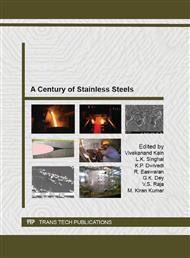p.691
p.697
p.705
p.714
p.731
p.741
p.749
p.757
p.766
Temper Embrittlement and Corrosion Behaviour of Martensitic Stainless Steel 420
Abstract:
Tempering of alloy steels in the temperature range of 400-600 °C causes temper embrittlement i.e. decrease in notch toughness of the material and the nil ductility temperature is raised to room temperature and above. The fracture in temper-embrittled steel is intergranular and propagates along prior austenitic grain boundaries. The embrittlement occurs only in the presence of specific impurities, e.g. P, Sn, Sb and As. These elements have been shown to segregate along prior austenite grain boundaries during tempering. Similar type of temper embrittlement can occur in martensitic stainless steel (SS) if tempered in the temperature range of 450-600 °C. This paper reports a case of failure of components made from martensitic SS 420 due to temper embrittlement. These components were subjected to a temperature of 120 °C in the initial stages of service and had shown brittle fractures. Scanning electron microscopic examination of the fracture surface of both the components showed intergranular fracture. The microstructures of the failed components confirmed that the materials were in hardened and tempered condition. In addition, the microstructure revealed both intergranular corrosion (IGC) and intergranular cracking. The electron backscatter diffraction study also showed retained austenite in the first components material. The material undergoing IGC might be related to a wrong heat-treatment during fabrication and subsequent pickling procedures. To confirm this, a sample each from both the components was exposed to 5% nitric acid solution at 25 °C. The results showed very high corrosion rate and the attack was intergranular in nature. The failure of both the components was concluded to be due to wrong tempering treatment in the temperature range of 450-600 °C that cause grain boundaries to become susceptible to embrittlement and corrosion.
Info:
Periodical:
Pages:
757-765
Citation:
Online since:
September 2013
Price:
Сopyright:
© 2013 Trans Tech Publications Ltd. All Rights Reserved
Share:
Citation:


